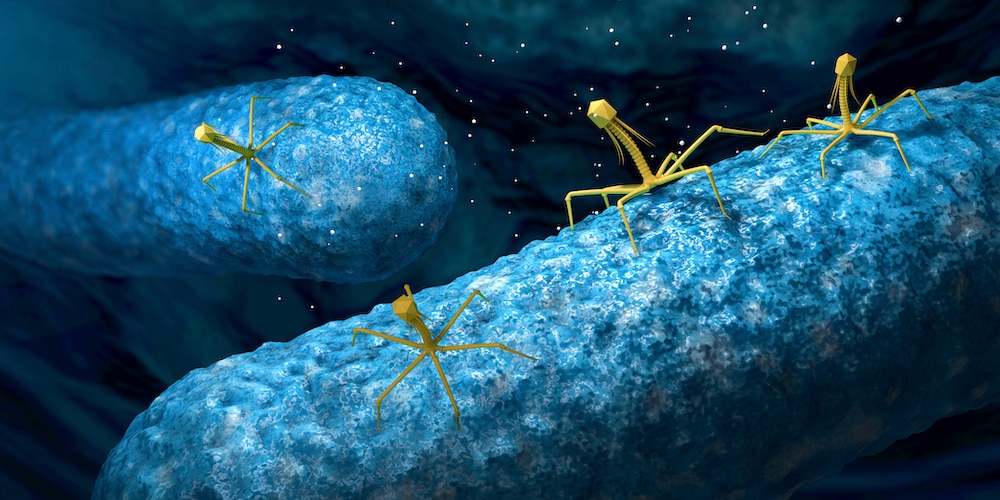Create a free profile to get unlimited access to exclusive videos, sweepstakes, and more!
Band-aids not helping with that infection? Try putting a virus on it
You wouldn't think of a virus as a treatment, but bacteriophages don't want your flesh.

Even most of the ghastly life-forms on Monsters Inside Me have nothing on this. When a wound refused to heal despite round after round of antibiotics, the cure was a viral invasion.
Wait. What? How can a virus make a festering infection vanish? Wouldn’t that mean a bacterial and viral infection that could be potentially lethal together? Not if the virus is a bacteriophage, a type of virus that invades bacteria instead of human cells. Bacteriophage literally means “bacteria eater.” These phages take down infectious bacteria like the antibiotic-resistant superbugs lurking in the wound of a woman whose severe wound otherwise refused to heal.
When phages were used with antibiotics, what happened was shocking. Led by internal medicine specialist Anaïs Eskenazi, doctors noticed that only days after the initial treatment, ooze was no longer seeping from the wound and the surrounding skin was starting to look human again. Ecologist and evolutionary biologist Paul Turner of Yale University, who was not involved in this study, but whose work has included extensive research on phage therapy.
“Phages specifically interacting with bacterial receptors used in antibiotic resistance should generally cause the bacteria to evolve phage escape, while compromising or eliminating the function of these receptors,” Turner told SYFY WIRE.
The woman in question suffered traumatic injuries after the 2016 bombing of Brussels airport, including a broken femur (thighbone) that had to be repaired with screws, pins and a frame to stabilize the bone while it healed. Except it didn’t. Supergbug Klebsiella pneumoniae saw this as an opportunity and swarmed in. This is the kind of infection that laughs in the face of antibiotics. Of the two strains found in the patient, one was especially stubborn. The bacteria formed colonies, or biofilms, and the 3D matrix of biofilms makes them almost impenetrable.
What is even scarier about biofilms (besides the thought of a massive colony of bacteria writhing inside your body) is that antibiotics may seem to kill off some of them, but cells deep in the biofilm may go dormant and reactivate later. This is why an experimental phage therapy was the last resort for this patient. Biofilms do have a weakness. They can be porous, which allows phages to creep in. They can then vanquish bacteria from within, causing the biofilm to come crashing down, and there are even phages which can unleash chemical weapons once inside.
“Some phages have chemical enzymes associated with the receptors that these viruses use to attach to cells, allowing the enzymes to break down compounds in the biofilm exterior, so that phages better attach to the exposed cells to initiate their cell-infection process,” said Turner.
Bacteria can still evolve phage resistance, but phages — especially when they join forces with powerful antibiotics — can also evolve to fight back. Turner’s research has helped reveal that bacteria are forced to change their antibiotic-resistant receptors to instead protect themselves when phages attack. Phages which interact with antibiotic-resistant receptors cause the evolution of phage escape in bacteria, which means compromising and possibly shutting down the receptors. This not only allows phages to have an easier time killing bacteria, but to find bacteria that is now less resistant to antibiotics after switching up its receptors to fight phages.
With less bacteria to fight, the immune system can then be more effective at getting rid of the infection. Bacteria also have more trouble developing phage resistance than they do antibiotic resistance. They can easily spread plasmids (free-floating structures containing DNA) which program them to resist antibiotics without a problem, but phage-resistant genes are in the actual chromosomes of bacteria and not on plasmids. They have to keep multiplying to pass on phage-resistant genes.
“Many of the mechanistic details of antibiotic-phage synergy are still being explored,” said Turner. “We need more research to understand the reasons for the success of so many promising results from emergency patient treatment cases.”
Fighting micro-monsters with other micro-monsters proved effective. The patient recovered after a combination of surgery, more antibiotics and mutant super-phages.


























